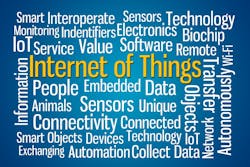Everyone acknowledges that the Internet of Things (IoT) has truly changed the technology landscape. In fact, many of the things we only dreamt about a few short years ago are now commonplace. As IoT begins to converge with sensors and analytics it’s evident that the technology landscape is poised to change yet again. And that change will impact industries across the board.
It’s not hard to imagine some of those scenarios that are probably just around the corner.
In Healthcare: Tomorrow’s Virtual Visit
A patient checks into a “smart” healthcare center for an outpatient procedure and is given an RFID tag. At the same time, reception activates a family member’s smartphone NFC wireless function via the hospital’s patient care application. Both become beacons that can securely share a specific set of information with nearby sensors.
The patient heads to pre-op and the family member with the smartphone walks over to a self-serve kiosk that senses they’re nearby. It greets them, verifies their identity and then pulls up a video of their loved one resting comfortably while awaiting surgery. “We’ll be back before you know it,” the nurse says reassuringly to the intelligent video surveillance dome camera, knowing the patient’s family is anxiously waiting. Within the hour, a notification pops into the family’s smartphone letting them know the patient is in recovery. A return to the kiosk lets them say a quick “hello.”
When the patient is ready to leave the facility, a facial recognition application verifies the patient’s location on exit which speed their check-in for the follow up visit.
For memory care facilities the converged technologies can be lifesaving. Should a patient attempt an “elopement” or unplanned wandering off-premises, cross-line detection software integrated with the facial recognition app automatically triggers a visual notification to a security officer’s smartphone to enable quick identification of the patient on the loose.
In Law Enforcement: Tomorrow’s Crime Fighting Intelligence
A special law enforcement team receives word of a nearby stash of illegal narcotics and weapons. Two members of the city’s gang violence reduction unit start a tour and soon get a “hit” off a surveillance camera equipped with license plate recognition (LPR) software linked to the NCIC. The match came from the “hot list” recently uploaded to the camera’s network attached storage device from the city’s crime analysis software which included the vehicle registration of a known gang member associated with the primary suspects.
A “beacon” application notifies the team and the command center that the vehicle has been spotted. The camera is equipped with “next generation” data compression software, so a clip of the vehicle passing by the camera is pushed to law enforcement on site. The camera transmits crucial details enabling the team to see that the vehicle’s occupants are armed with automatic weapons.
Knowing the location of their law enforcement assets, command automatically pushes out notifications of the filtered social media chatter to the nearby detectives and tactical response team. The cloud-based social media app has been listening for known gang language, keywords and locations, focusing specifically on the intel that is most vital to this operation. After obtaining a warrant, the unit leader requests the “go-ahead” for the operation from command. A traffic management application creates a protective radius around the site operation, freezing traffic and dispatching EMS for potential injuries and HAZMAT should there be toxic drug production onsite. The team executes the warrant and takes key gang members into custody.
The Roadmap for Tomorrow’s Robust IoT
What makes these futuristic scenarios possible is the fusion of a well-run IoT ecosystem coupled with the ubiquitous development of social media. But for this convergence to truly be feasible hundreds of these scenarios need to be able to be running continuously in many thousands of locations simultaneously. Furthermore, the analytics need to be sufficiently advanced to quickly present tactical profiles and response scenarios with minimal monitoring and interpretation.
So the million dollar question is: Can the convergence of IoT, sensors and analytics meet these benchmarks? From all indications, it seems a safe bet that it will.
Scalability. We’re already seeing scalable improvements in every part of the IoT puzzle. Sensors like IP cameras are more powerful than ever. And while it takes a significant amount of consistent processing for HD-quality images, more powerful compression standards are reducing bandwidth and storage consumption by at least 50 percent. With greater processing power in-camera, analytics like LPR and facial recognition can now run more efficiently at the edge or, in more contemporary terms, as a node on the IoT network. And that IoT network continues to expand to include devices like smartphones and “wearables,” as well as storage services in the cloud, attached to the network or embedded in the sensors.
Connectivity. Connectivity is key. It has to be cost-effective, reliable and secure. According to Nokia, 10,000 times more traffic will need to be carried through all mobile broadband technologies at some point between 2020 and 2030. That includes everything from laptops and tablets, to smartphones and Bluetooth-enabled cars to other IoT devices as yet to be invented. The exponential growth in subscribers demanding better voice, video and mobile broadband experiences has been persuasive motivation for the industry to develop a strategic roadmap for building out their networks to handle future extreme capacity and performance demands. The need for more capacity goes hand-in-hand with access to more of the spectrum on higher carrier frequencies. New 5G systems will need to be designed in a way that enables deployment in new frequency bands.
Security. Security of devices and applications on the network is another major issue affecting IoT's adoption. With all these devices, how can we prepare against seemingly endless security vulnerabilities? According to Good Technology Chief Executive Officer Christy Wyatt, the key question is “What data is ending up on what device and how do I protect it? Cyber security is a journey not a destination.” Deploying IP cameras capable of handling digital certificates to verify they are “trusted” non-person entities on a network will be essential to scaling IoT security. One method is to validate the identities and permissions of both the IP cameras and the consumers of the digital multimedia content on the network.
IoT in Action Today
While IoT continues to evolve, a number of industries – from transportation to retail to public safety – are already reaping its benefits.
Railroads. The Union Pacific Railroad currently uses IoT to monitor equipment and people to ensure the safety and security of its operation. IoT devices like acoustic sensors and IP cameras placed on or near tracks verify the integrity of train wheels and help predict equipment failures and reduce derailment risks. As a result, the Union Pacific has been able to reduce bearing-related derailments, which otherwise could have resulted in catastrophic events, costly delays, and as much as $40 million in damages per incident. By applying analytics to sensor data, Union Pacific can predict both imminent problems and potentially dangerous developments well in advance. Management now informs train operators of potential hazards within five minutes of detecting anomalies in bearings or tracks.
Retail. Retailers are applying IoT technology in innovative ways to enhance their customers’ buying experience. Heat mapping and dwell time analytics are helping management identify store hotspots and coldspots for merchandising opportunities and loss prevention. IoT shelf sensors working in conjunction with video cameras and location “beacons” track in-shelf availability and inventory for merchandise optimization and mobile payments. Demographic analytics detect the proximity of certain customer groups and trigger in-store video commercials for merchandise that might appeal to the target market.
Public safety. Public safety professionals are actively evaluating the benefits of IoT devices, not only to do their job better, but also for personal safety. Paramedic Don MacGarry of Loudon County Fire and Rescue in Virginia observes that, “If we were able to track [first responder] status using technology tools, the on-scene commanders would know what is happening in real time.” That possibility is now becoming a reality with the announcement of an exciting new program called the Next Generation First Responder Program introduced at the recent Public Safety Summit held by the Video Quality in Public Safety (VQIPS) working group of the Department of Homeland Security Science and Technology Directorate (DHS S+T).
A number of wearable IoT devices are under consideration for this program, including chemical, biological, gas and explosives sensors.
Whether giving police officers a tactical picture of where an active shooter is, or showing firefighters the safe ingresses and egresses of a burning building, IoT devices and their ecosystem are serving as crucial tools for helping first responders assess the situation and respond appropriately to quickly control it and positively impact the safety of our cities.
About the Author: Steve Surfaro is the industry liaison for Axis Communications. He also serves as the chairman of Security Applied Sciences for ASIS International. He can be reached at [email protected].


